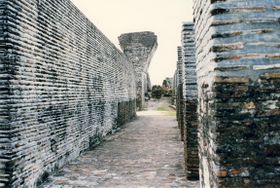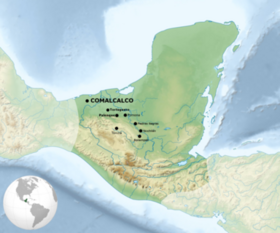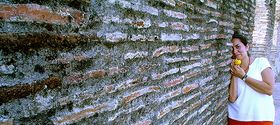Magische Orte - Comalcalco
Eine römische Stadt im vorkolumbischen Amerika?
(dg) Die antike Stätte von Comalcalco im mexikanischen Bundesstaat Tabasco gehört wegen ihrer Backsteinbauweise zu den ungewöhnlichsten Anlagen in ganz Mittelamerika. Die zweifellos der Maya-Kultur zuzurechnende archäologische Stätte lag an einem alten, etwa 10 km südlich der Golfküste verlaufenden Handelsweg und lässt schon aufgrund ihrer Lage eine gewisse Besonderheit vermuten. Die Jahre lange Zusammenarbeit mit Dr. Horst Friedrich hat mir tiefe Einblicke in diese einzigartige Mayastadt vermittelt, denn dort wurden fast ausschließlich gebrannte Ziegelsteine zum Bau verwandt.
Die Bauten der wohl schon im 2. Jahrhundert v. Chr. existierenden Stätte können – trotz des weitgehenden Fehlens von Stelen mit Maya-Datierungen – aufgrund ihres Bauschmucks in die Zeit der Spätklassik (ca. 550–900 v. Chr.) der Maya-Kultur datiert werden.
Am merkwürdigsten ist das Baumaterial. Comalcalco ist der einzige Ort im gesamten präkolumbischen Amerika, wo Ofen gebrannte Ziegel zum Tempelbau verwendet wurden. An anderen Orten wurden in der Sonne getrocknete, auch Adobe genannte, Ziegel benutzt. Ebenso haben die Maya dort auf die Verwendung von Kalkstein verzichtet. Um dem Ganzen noch eines drauf zu setzen, haben die Archäologen festgestellt, dass fast alle der gebrannten Ziegel über Maurerzeichen verfügten, die den römischen auf der anderen Seite des Atlantiks verblüffend ähnlich sehen. Hinzu kommen Köpfe aus Terrakotten, die ebenso fremdländische Gesichter abbilden. Konnte es da eine transatlantische Verbindung gegeben haben?
Dass Comalcalco keine Exklave der Römer in Mittelamerika war, sondern eine in vieler Hinsicht typische Maya-Stadt, ist allen Erkenntnis offenen Forschern bewusst. Comalcalco war kein Resultat gezielter altweltlicher Kolonisierung durch eine große Anzahl über den Atlantik gelangter Kolonisten, die sonst weitaus mehr Spuren hinterlassen hätten. Forscher, wie Robert Schoch oder Horst Friedrich, plädieren jedoch dafür, dass Comalcalco vermutlich das Ergebnis einer kurzzeitigen kulturellen Diffusion, die durch eine kleine Gruppe, womöglich an den Gestaden des Maya-Gebiets gestrandeter Römer, unter denen sich offenbar auch Bauarbeiter bzw. Maurer befanden, gewesen sein könnte. Diese stellten dann den Bauherrn der Stadt und deren Architekten ihre Kenntnisse zur Verfügung, bildeten örtliche Arbeiter in der Ziegelbrennerei und dem Maurerhandwerk aus und trugen als kleine Gruppe zu den Bauarbeiten bei.
Die Maya-Forschung beschäftigt sich wenig mit diesem seltsamen Ort in Mexiko. Die Ruinen von Comalcalco werden uns auch weiterhin vor Rätsel stellen, die wir nur lösen können, wenn wir uns von dem althergebrachten Paradigma einer isolationistischen Kulturentwicklung der Zivilisationen des Altertums lösen.
Die Architektur der Sakralbauten als auch die Templebauweise ist eindeutig der Maya-Architektur zu zuschreiben. Doch warum haben die Maya ausgerechnet hier, auf alle anderen Materialen, wie Kalkstein oder Aldobeziegel, verzichtet? Zufall oder begünstigt durch die Meereslage ein Hinweis auf einen überseeischen Kontakt? //
The architecture of the sacred buildings as well as the temple construction can clearly be attributed to Mayan architecture. But why did the Maya renounce all other materials, such as limestone or aldobe bricks, here of all places? Coincidence or favored by the sea situation an indication of an overseas contact?Die Nahaufnahme mit der Frau im Hintergrund zeigt die Größe der gebrannten Ziegel als auch deren schmales Format. Das erinnert stark an römische Ziegel. Hinzu kommen die Maurerzeichen, die ebenfalls Hinweise für einen Kontakt liefern.//
The close-up with the woman in the background shows the size of the fired bricks as well as their narrow format. This is very reminiscent of Roman bricks. In addition, there are the mason's signs, which also provide clues for contact.
++++++++++++++++
Magical Places - Comalcalco A Roman city in the pre-Columbian America?
The ancient site of Comalcalco, in the Mexican state of Tabasco, is one of the most unusual sites in all of Mesoamerica because of its brick construction. The archaeological site, which can undoubtedly be attributed to the Maya culture, was located on an old trade route running about 10 km south of the Gulf Coast and, due to its location, suggests a certain specialty. Years of collaboration with Dr. Horst Friedrich gave me deep insights into this unique Maya city, because burned bricks were almost exclusively used for construction there.
The first buildings were probably constructed already in the 2nd century B.C. Existing sites can be dated to the Late Classic period (ca. 550-900 BC) of the Maya culture, despite the extensive lack of stelae with Maya dates, due to their architectural decoration. The strangest thing is the building material. Not just in Comalcalco, but throughout pre-Columbian America, where kiln-fired bricks were used to build temples. In all other places, sun-dried bricks, also known as adobe, were used. Likewise, the Maya renounced the use of limestone there. To top it all off, archaeologists have found that nearly all of the fired bricks had features that look strikingly similar to the Roman ones across the Atlantic. There are also heads made of terracotta, which also depict foreign faces. Could there have been a transatlantic connection?
All open-minded researchers are aware that Comalcalco was not an exclave of the Romans in Central America, but a typical Mayan city in many respects. Comalcalco was not the result of deliberate Old World colonization by a large number of transatlantic invaders who would have left far more obvious marks. However, researchers such as Robert Schoch or Horst Friedrich argue that Comalcalco was probably the result of a short-term cultural diffusion caused by a small group of Romans who were possibly stranded on the shores of the Maya region, among whom were apparently also construction workers and bricklayers could be. They then made their knowledge available to the city's builders and their architects, trained local workers in brickmaking and masonry, and contributed as a small group to the construction work.
Maya research has paid little attention to this strange place in Mexico. The ruins of Comalcalco will continue to pose puzzles that can only be solved by breaking away from the traditional paradigm of isolationist cultural development of ancient civilizations.




